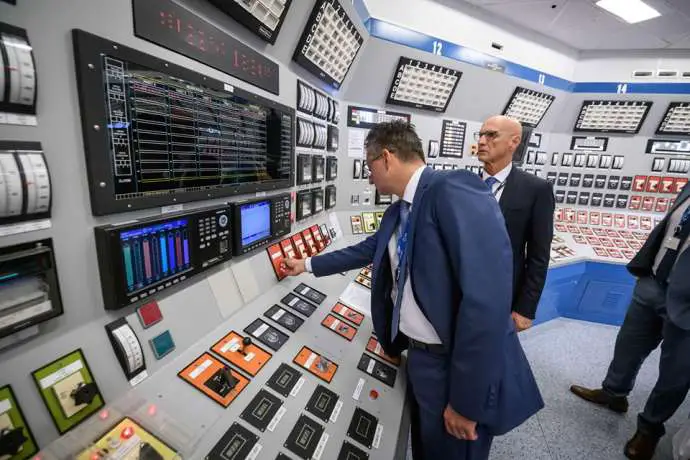STA, 22 August 2019 - Prime Minister Marjan Šarec visited Slovenia's sole nuclear power plant in Krško on Thursday, calling for "investing all our efforts to build a second reactor" to replace the current one beyond 2043.
"We need to invest all our efforts in this and set out to build a second reactor because in the future we will need ever more electric power, in particular if we want to be a development-oriented country," Šarec said during a visit to the Krško Nuclear Power Plant (NEK).
"In light of the changes in the field of energy and a rethink about the future sources of energy, a decision will have to be made soon what direction Slovenia wants to take," Šarec said.
"With the power station's management we have established that Slovenia is definitely a nuclear country considering that NEK generates a significant portion of our electricity, and we'd soon feel its loss," the prime minister added.
The existing reactor is slated for closure in 2043, by roughly which time the Šoštanj coal-fired power station TEŠ will have ceased to operate, so Šarec believes Slovenia needs to decide what energy policy it will pursue.
"If we don't want wind farms or thermal plants and other sources of energy, we'll soon find that there's nowhere we can get energy from," said Šarec, calling for more effort to attain energy self-sufficiency.
The rate of unscheduled outages of NEK since 1983 has been reduced to virtually zero and the power station has been performing successfully, Šarec said. "Since becoming operational, the amount of energy it supplies has increased equal to an output of almost ten hydro power plants."
Šarec spoke to reporters after meeting NEK CEO Stane Rožman and Martin Novšak, the CEO of Gen Energija, the state-owned company that owns the Slovenian half of NEK. The pair were happy with the talks.
"I believe we have many opportunities to build a bright carbon-low future," Novšak commented, with Rožman adding that they had asked Šarec for his support in principle for their plans.
They also discussed the national climate and energy plan whose draft does not discuss nuclear energy, although the prime minister believes it should.
"I expect professionals to decide in the end because decision-making is too often left to those who are driven by emotions rather than by expertise," said Šarec, who sees positive effects of nuclear energy outweighing negative ones.
A decision on potential construction of a new reactor should be taken as soon as possible because it would take at least a decade from the time the decision is taken to when the reactor is built.
Gen Energija has conducted a number of studies to prove that the location and technology is right, while permits are still pending, and so is the project's zoning.
"There's also tenders, development permits, [planning] operation and decommissioning," said Novšak, who would like the national climate and energy plan to state clearly that the country would keep nuclear energy in the future.
Šarec also faced questions about the difficulties surrounding major infrastructure projects in Slovenia, admitting that TEŠ 6 generator was a "sad story", but would not speculate on who was responsible.
The biggest problem is the spatial planning of such projects, and there is the question of legislation. "Once we don't have a referendum on each thing because of everyone who has five minutes to spare, things will go in the right direction," he said.
The prime minister has not yet tested coalition support for a second nuclear reactor and would not speculate whether other countries could be involved in its construction and financing. "I will make the effort though that Slovenia remain independent energy-wise," he said.
Owned jointly by Slovenia and Croatia, the plant began operating at full capacity in August 1982, launching commercial operation in January 1983.
The foundation stone for the plant was laid in 1974 and construction started a year later. After the first phase of trial operation in May 1981, the plant transmitted first kilowatts of power into the national grid in October that year.






